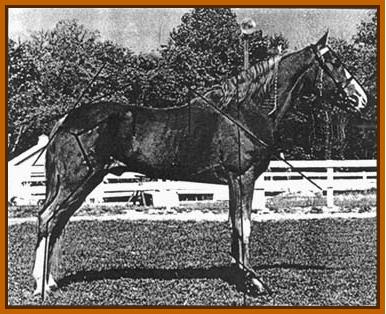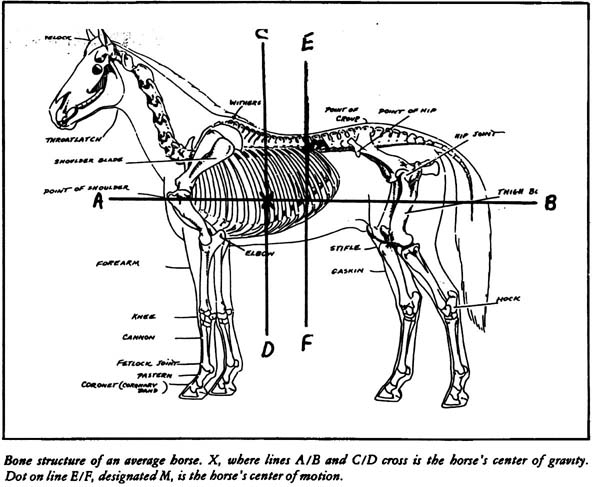|
|
||
|
Some tips on
conformation |
||
|
Click on the fish
|
||
|
|
||
|
Conformation of the true,
natural gaited Walking Horse. |
||
|
This study of how conformation of the horse relates to his way of moving will present some guidelines for selecting a horse that will perform the true, natural running walk. Conformation is definitely the most important factor to be considered in the selection and breeding of the Tennessee Walking Horse. The perpetuation of the breed depends on the judges and the breeders. They must fully understand the science of the laws of force and motion and how these dynamics depend on conformation. It must also be understood that conformation is inheritable and cannot be altered by man. Everyone is entitled to his opinion of what constitutes the best conformation, but as they relate to the Walking Horse they must be learned opinions. We can no longer afford the luxury of randomly breeding horses who have to be made to walk by artificial aids. Perhaps the most important factor to consider when examining the conformation of the Walking Horse is the angle of the shoulder in relation to his legs and total body. In making this observation, it is well to feel the shoulder with both hands. This will help you to determine the true angle of the shoulder. Also, you will feel the scapula and begin to understand the skeletal structure of the shoulder. The middle of the shoulder blade and the spine of the scapula tells you what the true angulation of the shoulder is going to be. Just looking from the point of the shoulder to the top of the withers can be misleading. Some horses have shoulders out on the front and still have a straight up and down scapula. These can look like sloping shoulders but they are just out at the front end. Muscle structure in this area can also deceive the eye, so when making this important observation the actual palpation of the area is important.
|
||
|
|
||
|
The model shown is
Merry Boy's F88, |
||
|
|
||
|
|
||
|
|
||
|
The main reason
for assigning so much importance on the angle of the shoulder is
because, Now the legs must be examined from the front, left and right front, both sides, the rear, and left and right rear. These legs have supported the horse since minutes after he was foaled. He is forced to compensate and make do with any faults the legs might have until the day he dies. When selecting a horse that is expected to perform a natural running walk, no compromise can be made for any fault of conformation that distracts from our goal. From every angle the legs should be straight, utilizing the total column of bone, muscle, tendons and ligaments. This straightness cannot be over-emphasized. To fully examine the many types and problems of crooked legs would add too much to this particular discussion. Just make certain the legs are straight. The front legs will support 60 to 65 percent of the total weight of the horse. They should come out of the shoulder somewhat closer together than they do in most other breeds. However they should not be so close that cross firing might occur. The feet should set apart on the ground the same distance as the limbs are apart as they leave the body. The front pastern should have about the same angle as the shoulder with the rear pasterns being 5 to 10 degrees straighter. The angle of the front hooves should range between 45 to 50 degrees and the rear hooves about 50 to 55 degrees. The length of the legs should obviously be in proportion to the size of the body. They should join in the overall conformation so the horse will be lower in the rear than at the withers. Thus, no additional weight is tilted forward on an already over weighted front end. The length of the upper front leg from the knee up should be longer than the lower leg. A good rule of thumb is that the upper leg cannot very well be too long while the lower leg cannot very well be too short. The knee and lower leg should be well formed with size in proportion to the upper leg. The hoof should be well formed and full. Narrow hooves would indicate contracted heels. It is only here that any attempt can be made to somewhat change the horses gait by altering the angle of the front and/or rear hooves. Each individual horse will have to be assessed as to which angle will make the desired gait easier for him to perform. To this end, a slight change in the weight of the shoes either front or rear can be an advantage.
|
||
|
|
||
|
|
||
|
|
||
|
We have all heard someone state their preference for a horse with flat boned legs. In reality, the horse has only flat bones in his head, ribs and some small bones. The most efficient bone is a cylinder. The leg appears as if it has flat bones if the cannon bone is large with suspensory ligament, a deep flexor tendon and a superficial flexor tendon that is big enough to go with the bone. Thus, most old timers knew when the legs possessed the right appearance even though their description may not have been technically correct. In most instances, the conformation that contributes to the correct mobility of the Walking Horse will also contribute to the necessary absorption of shock to keep the horse sound. This is one of the reasons we have used a 26 year old stallion as our model. Throughout his life, this horse has remained completely sound. It is universal in all breeds that the head and neck should show a high degree of excellence of conformation. The head and neck serve as the balance arm to the horse when he is in motion. The head should be neat and trim so as not to add any unnecessary weight to the balance arm. The face should be flat, wide between the eyes, with large expressive eyes out on the corner of the forehead. When the horse has his head down grazing, nature intended that he see almost a 360º area. If he is pig-eyed with eyes deep in the sockets, or the eyes are located on the side of the head, he cannot see properly. If the face bulges between the eyes or if he has a roman nose, it will interfere with his sight. We want the horse to see properly, as one who does not is almost always bad mannered. Anyone that has been around a horse that is going blind knows this to be true. The head should taper well to the muzzle. The lips should be small and tight. The nostrils should be large so that he will be able to get the proper supply of oxygen. The ears should not be too large and should set on top of the head. The horse expresses himself with his ears and eyes. By observing them under different conditions we can learn a lot about a horses intelligence and disposition.
By using the length of the head as a unit of measure, the following
proportions of a horse may be quickly observed. Thus if the horse has a large coarse head he will probably be lacking in other points of conformation. The neck should be moderately long, full, slightly arched with a neat crest, and it should gracefully become larger as it approaches the shoulders. With the fact that the head and neck is used by the horse for balance, the nodding of the head of the Walking Horse seems a natural function. The downswing of the head aids in locomotion as it pulls on the neck and back muscles. The Walking Horse must have a straight, short back. The loin muscles should be well developed as the horse has to tense the whole spinal column before he can pick up his total front end and propel it forward. All the sensory nerves which send signals to the brain to cause muscles to contract and result in motion are in the back. The center of motion is at the point considered the center of the back, usually at the fifteenth or sixteenth vertebra. The center of gravity is somewhat farther forward as we know the horse is somewhat heavier in the front. This point is usually at the eighth or ninth vertebra. Extra caution should be taken not to place the saddle too far forward. The already overweight front end should not have to take more than it's share of the rider's weight. Overall size of the Walking Horse selected can be left to personal preference. Size has little relationship to the degree of perfection of conformation. Just be sure the points of conformation meet a standard of excellence and that they are bound together in the proper manner. With the guidelines for correct Walking Horse conformation put forth in this article, the novice should be able to select a natural Walking Horse. Now for those of you who do not now own a natural gaited Tennessee Walking Horse, please follow this advice. Go shopping and buy one. The monetary cost will be an investment that will pay the highest dividends in a lifetime of healthful joy. |
||
|
|
||
|
|
||
|
ROSE CREEK WALKING HORSES We let the Walkin do
the Talkin! |
||
|
MAIN
ABOUT US MARES
STALLION FOALS JUST
SAY SABINO GROOMING TIPS |
||



